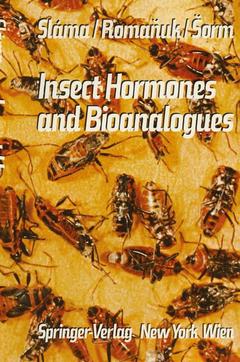Insect Hormones and Bioanalogues, Softcover reprint of the original 1st ed. 1974
Langue : Anglais
Auteurs : Slama K., Romanuk M., Sorm F.

The application of organic insecticides in the agrotechnical praxis resulted in a great and unexpected progress in the control of insect pests, and was of a great economical value all over the world. The widespread application of these agents, however, is also accompanied by negative effects. The principal drawback of classical insecticides consists in the lack of their specificity, the useful insects being killed together with insect pests. Furthermore, the broad-scale application for many years led to the formation of more resistant insect strains requiring higher and higher doses of insecticides. The residues of the mostly used chlorinated compounds accumulate in human and animal foods producing directly or indirectly harmful effects in human sub jects. The critical situation led in many developed countries to the restriction in the usage of some types of classical insecticides. Under these circumstances it is quite natural that novel routes for the control of insect pests are investigated. In this connection, attention has been paid especially to the insect endocrinology and insect hormones which regulate the admirable and in many regards specific development from the egg to the adult insect. The recent successful discoveries in this field are thus in close relation to the practical requirements. Isolation and identification of moulting hor mones and juvenile-hormone-like naturally occurring substances not only made possible an exact investigation of their physiological effects but also stimulated the chemical research.
I. Brief Survey of the Neuroendocrine System in Insects.- A. The Neurosecretory System and the Activation Hormone (AH) (K. SLáMA).- 1. Structure of the Neurosecretory Cells and Neurohaemal Organs.- 2. Formation and Release of Neurosecretory Material.- 3. Changes in the Neurosecretory System during Development.- 4. Adenotropic Effects of the Activation Hormone.- 5. Survey of Physiological and Biochemical Effects.- 6. Other Effects of Neurohormones.- 7. Chemical Nature of the AH and other Neurohormones.- 8. Other Proteinaceous Neurohormones with Specific Effects.- B. Corpora Allata (CA) and the Corpus Allatum Hormone (CAH) (K. SLáMA).- 1. External and Internal Anatomy and Morphology of the CA.- 2. Growth and Secretory Activity of the CA during Development.- 3. Action of CAH during Larval Growth and Metamorphosis.- 4. Action of CAH on Reproduction and Adult Diapause.- 5. Physiological and Biochemical Effects of CAH.- 6. Survey of other Effects of CAH.- 7. Chemical Nature of CAH.- C. Prothoracic Glands (PG) and the Prothoracic Gland Hormone (PGH) (K. SLáMA).- 1. External and Internal Morphology of Prothoracic Glands.- 2. Changes in PG during Postembryonic Development.- 3. Effects of PGH on Growth, Differentiation and Moults.- 4. Some Physiological and Biochemical Effects of PGH.- 5. Chemical Nature of the PGH.- References.- II. The Chemistry and Physiology of Juvenoids.- A. Introduction (K. SLáMA).- B. Methods of Testing and Evaluating the Biological Activity of Juvenoids (K. SLáMA).- 1 Developmental Stages Suitable for the Assays.- 2. Methods of Juvenoid Application.- 3. Evaluation of the Assay Results.- 4. Instructions on Some Biological Assays with Juvenoids.- 5. The Use of Bioassays for Studies on Transport and Stability of Juvenoids.- C. Chemistry of the Juvenoids.- 1. Introduction (M. ROma?uk).- 2. Acyclic Juvenoids (M. ROma?uk).- 3. Cyclic Juvenoids (F. ŠOrm).- D. Structure-Activity Relationships (M. ROma?uk and K. SLáMA).- 1. Physical Properties of Juvenoids.- 2. Molecular Size.- 3. Shape of the Carbon Skeleton in Acyclic Juvenoids.- 4. Double Bonds and Geometrical Isomerism.- 5. Role of Hetero Atoms.- 6. Juvenile Activity of Optical Isomers.- 7. Chemical Structure and Species Specificity.- E. Physiological and Biochemical Effects of Juvenoids (K. SLáMA).- 1. Developmental Periods Sensitive to Juvenoids.- 2. Physiological Conditions for Induction of Supernumerary Instars and Intermediate Forms.- 3. Effect of Juvenoids on Growth and Duration of the Intermoult Cycles.- 4. The Nature of Ecdysial Failures.- 5. The Nature of Juvenoid Effects on Differentiation.- 6. Effects on Reproduction and Adult Diapause.- 7. Action of Juvenoids on Embryonic Development.- 8. Physiological Conditions for Female Sterility.- 9. Relationships in the Effects on Metamorphosis, Embryogenesis and Reproduction.- 10. Synergism and Potentiation of Juvenoid Effects.- 11. Effects of Mitotic and Metabolic Inhibitors.- 12. Effects of Juvenoids on Respiratory Metabolism.- 13. The Effect of Juvenoids on Enzymatic Activity.- 14. The Effect on Carbohydrate, Lipid, and Protein Metabolism.- 15. The Effect on Metabolism of Nucleic Acids and on Puffing Patterns.- 16. The Mode of Action of Juvenoids.- 17. Possibility of Anti-Juvenile or Anti-Juvenoid Effects.- 18. Inactivation of Juvenoids in the Body.- 19. The Effect of Juvenoids on Prothoracic Glands and on Corpora Allata.- 20. Interactions between Plants and Insects by Juvenoids.- 21. Other Effects of Juvenoids, Action on Different Groups of Insects.- F. Juvenoids as Potential Pesticides (K. SLáMA).- References.- III. Chemistry and Physiology of Ecdysoids.- A. The Chemistry of Moulting Hormones (Ecdysones — Ecdysoids) (F. ŠObm).- B. Relations between the Structure and Activity of Insect Moulting Hormones (F. ŠObm).- C. Biosynthesis and Catabolism of Ecdysoids (F. ŠObm).- D. Steroid Compounds Interfering with Ecdysis (F. ŠObm).- E. Biochemical Effects of Ecdysoids (F. ŠObm).- F. Bioassays for Ecdysoids (K. SLáMA).- G. Physiological Effects of Ecdysoids (K. SLáMA).- 1. Developmental Stages Sensitivo to Ecdysoid Action.- 2. Physiological Conditions for Ecdysoid Action on Growth and Development.- 3. The Role of Ecdysoids in Puparium Formation.- 4. Excessive versus Small Doses and the Problem of Differentiation.- 5. Effect of Ecdysoids on Reproduction.- 6. The Content, Distribution, and Inhibition of Ecdysoids in the Body.- 7. Developmental Relationships between Ecdysoid and Juvenoid Actions.- 8. Effects of Ecdysoids on Metabolism.- 9. Ecdysoids and Growth of Tissue Cultures.- 10. Ecdysoids and Puffing Patterns on Polytene Chromosomes.- 11. Effect of Ecdysoids in other Animals and Plants.- References.- Preface.- List of Abbreviations.- Tables.- Alphabetical List of Juvenoids.- Addendum.
Date de parution : 02-2012
Ouvrage de 477 p.
15.5x23.5 cm
Disponible chez l'éditeur (délai d'approvisionnement : 15 jours).
Prix indicatif 105,49 €
Ajouter au panierThème d’Insect Hormones and Bioanalogues :
Mots-clés :
© 2024 LAVOISIER S.A.S.



